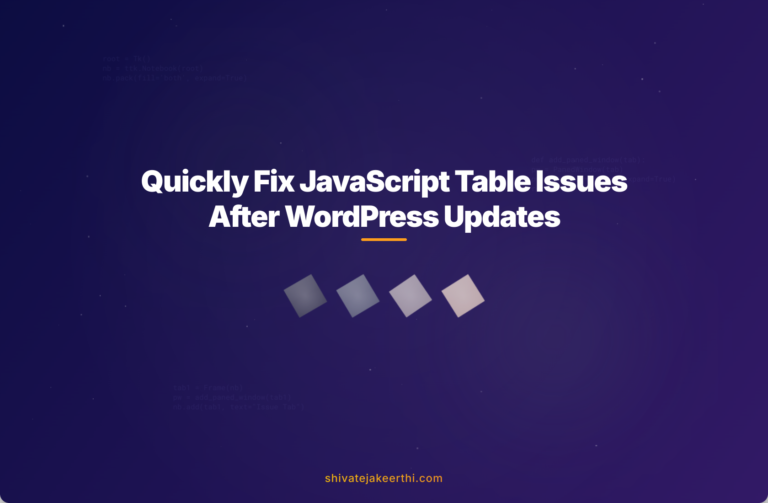JavaScript tables not loading after plugin and theme updates can quickly become frustrating. You’re running your website smoothly, and suddenly this critical functionality breaks—for seemingly no reason.
These tables often handle crucial product or order information. Getting those JavaScript tables back up and running quickly isn’t just convenient—it’s essential for keeping your customers happy and your business flowing smoothly.
Common Causes of JavaScript Tables Not Loading
Many things can cause JavaScript-driven tables to stop loading properly after updating your WordPress plugins or themes. Let’s discuss a few common scenarios to help narrow down the issue.
Plugin Conflicts
Plugins sometimes update their scripts, introducing JavaScript errors or conflicts. Even a small code conflict can prevent JavaScript tables from rendering correctly.
Theme Updates Impacting JavaScript Functionality
Theme updates often introduce changes in JavaScript dependencies and scripts. If your theme relies on specific JavaScript functionalities or libraries (like jQuery or Bootstrap), updates may inadvertently break your existing setup.
PHP Version Compatibility Issues
Upgrading your hosting environment to PHP 8.2 could lead to JavaScript table issues. While PHP and JavaScript operate differently, the connectivity framework (such as AJAX calls or JSON handling) can break down if compatibility isn’t thoroughly tested.
Troubleshooting Steps to Fix JavaScript Table Loading Issues
If you notice your JavaScript tables not loading properly, don’t panic. Here’s a methodical approach to identifying and solving the issue:
Review Plugin Updates Thoroughly
Your first stop should be your plugin list. Think back: Have you recently performed an update that coincides with this issue?
- Check for Known Conflicts: Visit plugin support forums or community resources like Stack Overflow to see if others have experienced similar issues. Developers often post known conflicts and quick solutions.
- Temporary Disable Plugins: By deactivating recently updated plugins one by one, you can pinpoint exactly which update caused your JavaScript table to stop working. Reactivate gradually to identify the conflicting plugin.
Examine Recent Theme Updates
Next, look into any recent updates you’ve applied to your WordPress theme.
- Check JavaScript File Locations: Theme updates sometimes reorganize JavaScript file paths or modify dependencies—breaking your table functionality. Review your browser’s developer console (press F12 or Ctrl + Shift + J in Chrome) to identify any missing or broken scripts.
- Consider Temporarily Rolling Back: If you identify issues after a new theme version rollout, try reverting a test environment to an earlier theme version and confirm if the problem resolves.
Verify PHP Version Compatibility
PHP updates don’t directly impact JavaScript execution, but indirectly affect AJAX calls or JSON endpoints. Particularly, migrating from PHP 7.x to PHP 8+ may lead to unexpected issues.
- Make sure your theme and plugins explicitly support PHP 8.2 (check theme documentation or plugin support pages).
- Downgrade temporarily to PHP 7.4 or 8.0 on a staging environment to confirm if PHP compatibility is indeed the issue.
Restoring Files and Database—The Cautious Way
If troubleshooting alone isn’t resolving the issue, you might need to restore files or your database from an earlier backup. Proceed with caution to ensure you don’t inadvertently lose significant recent changes.
File Restoration:
- Restore rarely-used or stable files initially, rather than overwriting your entire site. Restoring specific JavaScript-related files or dependencies could fix the issue without causing collateral damage.
- After restoration, run thorough tests to verify your tables and functionality before pushing these changes live.
Database Restoration:
Your database might be playing a role, especially if configuration settings in your database were modified during an update.
- Create a fresh database backup right away—this ensures recent order data or critical content isn’t accidentally lost.
- Once secured, carefully restore a past database version on a staging environment first. Verify if tables start loading correctly again, helping you target exactly where the problem lies.
Preventing Data Loss During Troubleshooting
Since troubleshooting involves a bit of experimentation, minimizing data loss risk is extremely important—particularly for e-commerce setups using tools like WooCommerce.
Here’s what to do:
- Backup WooCommerce Orders: Export important data, like WooCommerce orders, product data, and customer details. Plugins like UpdraftPlus or WooCommerce Customer Order CSV Export handle these tasks efficiently and regularly.
- Always communicate transparently with your organization or stakeholders about potential data risks, keeping everyone prepared and on the same page.
How to Safeguard Your Site from Similar Issues in the Future
You learned that plugin or theme updates, despite being helpful, can introduce unforeseen conflicts. To stay ahead, apply the following proactive measures:
- Set updates in a staging environment first, ensuring your production site remains unaffected by conflicts.
- Implement thorough backups, scheduled daily or weekly, according to your site’s activity level.
- Monitor update logs and release notes closely for warnings and compatibility notes.
Check out our detailed article on JavaScript best practices for more insights on preventing issues with JavaScript functionality in the future.
Quick Recap – Your Troubleshooting Checklist
Here’s a concise table summarizing your steps clearly for future reference:
| Step | Action |
| 1 | Review plugin updates (disable if necessary) |
| 2 | Check theme JavaScript changes or rollback theme version |
| 3 | Verify PHP compatibility and test rollback if needed |
| 4 | Easily restore files or databases from reliable backups |
| 5 | Protect and export critical WooCommerce data regularly |
| 6 | Carry out thorough testing before any permanent changes |
Resolving a JavaScript table issue quickly often takes patience and careful steps. Stay organized, keep track of changes, and always back up data first.
Are your JavaScript tables still giving you trouble? Feel free to share your experiences below, or reach out to a professional developer or to an active community like WordPress Stack Exchange for assistance. Remember, timely troubleshooting is key to maintaining a healthy, functional website.



0 Comments